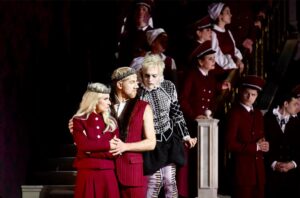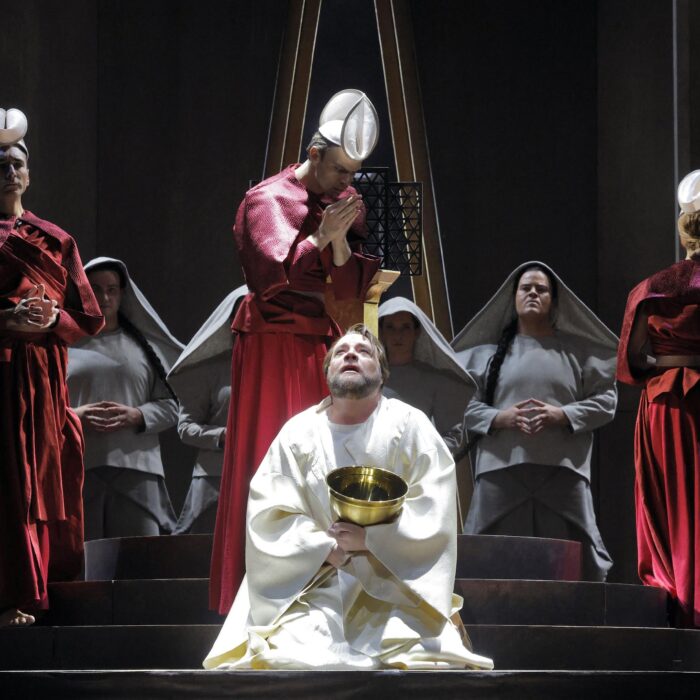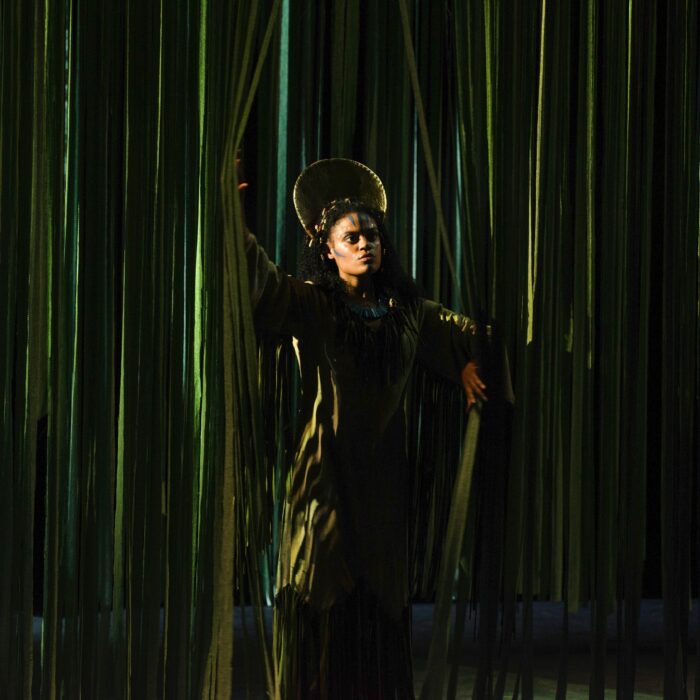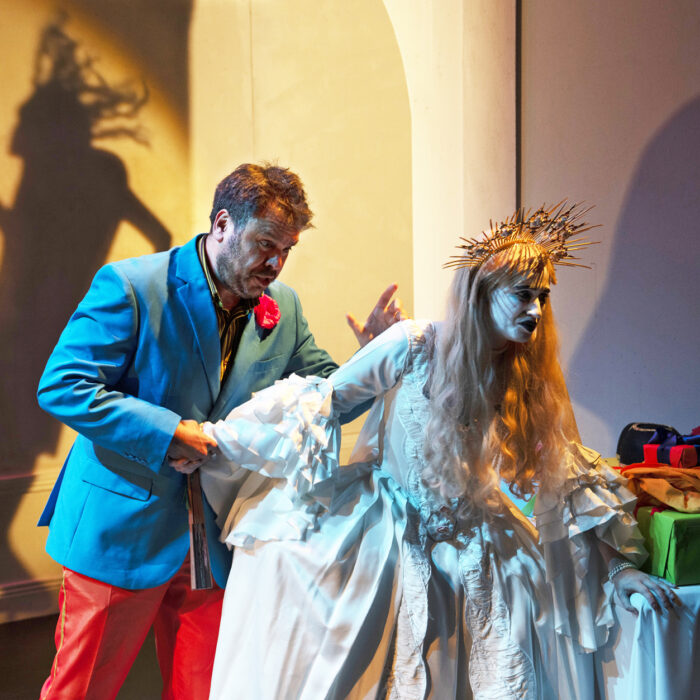
Komische Oper Berlin 2022-23 Review: Hamlet
Huw Montague Rendall & Liv Redpath Shine in Fantastic Grand Opera
By Zenaida des Aubris(Credit: Monika Rittershaus)
Thomas‘ “Hamlet” is not listed under the genre Grand Opéra without reason. It features opulent music, a large chorus, a sturdy length (a good three hours plus intermission), and the need for truly excellent leading actors. The Komische Oper Berlin, together with the team of conductor Marie Jacquot and stage director Nadja Loschky, took up this challenge.
And won.
The plot of the opera, first performed in Paris in 1868, with a libretto by Michel Carré and Jules Barbier, revolves around the Danish prince Hamlet, who seeks revenge against his uncle Claudius for the murder of his father. The opera follows Hamlet’s plot of revenge, his feigned madness, and the suicide of his fiancée Ophélie.
For this version of the production, the company presented the Parisian original version, which features Hamlet killing his uncle Claudius and proclaiming himself king.
Uncovering the Rot
Nadja Loschky set the first act of the opera in the entrance hall of a grand manor – it may even have been Kronborg, where Shakespeare also set his drama and which can still be visited today in Denmark. Stage designer Etienne Pluss built a wide staircase with an upper balustrade and to the left and right of the proscenium were small niches from which the actors could easily observe the action on stage. With pomp and glory, the newlywed royal couple appeared – Hamlet’s mother Getrude, who has just married Claudius, her late husband’s brother. Hamlet and the jester watched and commented – the prince horrified that his mother remarried so soon after her husband’s death.
Costume designer Irina Spreckelmeyer dressed the court in elegant burgundy tones, some period, some modern. Only Yorick, the mute jester, was allowed some sparkle in black and white breeches and a ruff – a counterpart to Hamlet, who wore modern, very casual too-short pants and a T-shirt.
Onto this fairly conventional set, there suddenly appeared three gravediggers in modern business attire with suit, umbrella, cane and top hat popping up from a grave. A first sign that “something is rotten in the state of Denmark?” They walked across the stage and were gone … only to reappear with floor plans, ladders and measuring instruments. Definitely investors on the prey with ulterior motives. These fringe characters mutely commented on the decay of the ruling family, even brought some wit to the gloomy halls and allowed the audience to understand why Hamlet and Yorick, at the end of the second act, began to attack the walls and masonry with pickaxes in search of the rot under the smooth surfaces.
And it was precisely this rot that became visible after the intermission – not much was left of the magnificent entrance hall now: Heaps of earth were piled up everywhere. Everything was decaying because life cannot blossom without truth, because the truth of murder has been buried. Hamlet delivered his famous soliloquy “to be or not to be” as the aria “Être ou ne pas être” with an obligatory skull in his hand; he then buried it. Unfortunately, this very core sentence from Shakespeare was not composed by Thomas in such a way that it became a world-famous aria, but rather a casual ballad. No comparison to the truly brilliant compositions for Ophélie.
Hamlet is clearly an outsider here, who does not give in to courtly life and intrigue, but has a sense of justice. Ophélie, daughter of the influential courtier Polonius – who turns out to be an accomplice to the murderer Claudius – is a kindred spirit to Hamlet. She, too, lives in her own enraptured world, and it is actually an action consistent with her character that she takes her own life after Hamlet tells her to “get thee to a nunnery.” Choreographer Thomas Wilhelm staged the ballet music to Ophélie’s dream of a happy marriage very lyrically, danced by two doubles, Ana Dordevic and Lorenzo Soragni, while she watched, entranced by her own vision.
Solid, Though Inconsistent, Musical Exploration
Ambroise Thomas composed music for expansive emotions – very much in the tradition of the Grand Opéra of the late 19th century: There are overwhelming chords with deafening timpani beats, but also delicate harp notes that express Ophélie’s love for Hamlet. Last but not least, Thomas integrates the then newly patented saxophone into the banquet scene in which Hamlet tries to expose his uncle as a murderer. His compositions highlight the psychological aspects of the characters and offer impressive arias and ensembles that illustrate the emotions of the protagonists. Conductor Marie Jacquot guided the Komische Oper orchestra with a sure hand through the many motifs and different tempi, making the rich timbres shimmer.
Baritone Huw Montague Rendall embodied the prince Hamlet with so much devotion, musicality and passion that it is no wonder that he seemed overwhelmed by the grandiose final applause. Not only did his lyrical baritone always remain firm, but his entire facial expression and physicality showed that he was fully involved in the role of the young, desperate, Danish prince. His physical and psychological agility were perfect, and the intensity and naturalness of his playing and singing went hand in hand.
As his partner Ophélie, Liv Redpath was on the same high level. Like Hamlet, she too, was blonde and costumed in light hues. Ambroise Thomas wrote two arias for her role that are considered highly challenging in the coloratura soprano repertoire. Redpath mastered them both, especially the madness aria, with lyrical, even soaring, assured high notes. One could hardly wish for a more beautiful and fitting pair of lovers. The good French pronunciation of both added to the enjoyment of their singing.
Next to these two outstanding young singers, the rest of the ensemble seemed somewhat pale. Soprano of Karoline Gumos, as Queen Gertrude, sounded sharp at times, but this actually suited her conniving chartacter.
Among the men, Jens Larsen’s old king stood out, precisely because his bass was brittle and thus perfect as a menacing yet dignified ghost.
Tijl Faveyts embodied King Claudius with a sonorous and cultivated baritone – and the dramatic air of an usurper with a bad conscience.
Tenor José Simerilla Romero rendered the comprimario role of Laerte, brother of Ophélie, with elegance.
The various other supporting roles – bass-baritone Stephen Bronk as Polonius, bass Frederic Jost as Horatio, tenor Johannes Dunz as Marcellus – fulfilled the dramatic and musical demands.
Although a mute role, Kjell Brutscheidt mimed as the jester Yorick. As a counterpart to Hamlet, he complemented and supported him as an alter ego in his interactions with the king and queen and the court. Brutscheidt proved to be an agile actor with a great deal of personal charisma.
Berlin was lucky enough to experience Hamlet in concert at the Deutsche Oper in 2019. At that time, the work was very well received by the audience. Now this fully staged production at the Komische Oper was met with overwhelming applause for the soloists, chorus, orchestra and production, especially Montague and Redpath. It is undeniably a rediscovery well-worth keeping in the repertoire.



